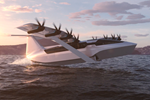Post Cure: Composite seaglider craft redefine coastal transportation operations
The Viceroy all-electric flagship seaglider being developed by REGENT Craft in Rhode Island operates exclusively over water.
An interior view of the hull of REGENT’s full-scale seaglider prototype during fabrication. Source Source | REGENT Craft
(North Kingstown, R.I., U.S.) is making waves to better connect coastal communities through all-electric maritime transportation. REGENT’s hydrofoiling wing-in-ground effect all-electric seaglider — with float, foil and fly modes — uses carbon fiber for high-speed travel. The Viceroy seaglider, at 55 feet long with a 65-foot wingspan, will hold 12 passengers or up to 3,500 pounds of cargo payload and travel routes up to 180 miles at 180 miles per hour. Entry into service is expected for late 2026 or early 2027.
REGENT uses various out-of-autoclave processing techniques for the development of seaglider composite parts and structures including infusion, wet layup and compression molding depending on the size and type of parts. Materials involved include highly optimized unidirectional tapes, various twills and weaves, and sandwich panels using closed cell foam core and Nomex honeycomb core. The company has designed and built parts from brackets to 20-meter wing skins and spars. REGENT also uses a variety of joining techniques —bonded, bolted or taped — depending on the criticality of the joint.
Related Content
-
Post Cure: Bionic fiber placement produces load-optimized, nature-inspired thermoplastic composite preforms
Fibionic’s fibionic fiber placement (FPP) technology enables the development of “fiber skeletons,” semi-finished parts suitable for any application that incorporates composite reinforcement exactly where it is needed.
-
Post Cure: Parallel winding technique demonstrates CFRP anisogrid design optimization
Over the years, CIRA has demonstrated its patented CFRP parallel winding technique in a variety of ways for space applications. The lattice structure for the Vega-C launcher stage is a prime example.
-
Post Cure: Tool-less direct extrusion enables efficient, complex composite structure development
Backed by AI software, Hans Weber’s large-format 3D printing capabilities resulted in the successful development of a Savonius wind turbine blade in under two hours.



